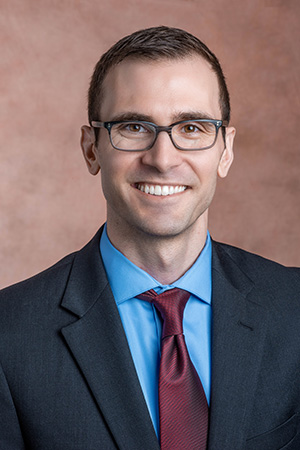
Three years ago, when he had the distinction of being the first-ever fellow in the Simulation program at Western Michigan University Homer Stryker M.D. School of Medicine (WMed), Neil Hughes, MD, said his ultimate goal as a physician and educator was to one day join an institution where he could work as a dean for simulation.
Mission accomplished.
In June, Dr. Hughes, an alumnus of the WMed Class of 2019 and an assistant professor in the Department of Medicine, will become the medical school’s new assistant dean for Simulation.
“My rise to assistant dean is definitely unusual but it also feels like a natural progression for me personally,” Dr. Hughes said. “I’ve seen almost every position in our Simulation Center from the ground up and this felt like the natural next step based on my experience, my training, and everything I’ve learned over the years.”
Over the last 13 years, Dr. Hughes has had a front-row seat to witness the growth and evolution of the WMed Simulation Center. He began working in the center in 2012 shortly after graduating from Western Michigan University and he was part of laying the foundation for what the 24,000 square-foot facility in the lower level of the W.E. Upjohn M.D. Campus has become today.
In 2015, Dr. Hughes came to WMed as a member of the medical school’s second class of future physicians and honed his skills running through simulations and exercises that prepared him and his classmates for real-world patient care and emergencies. He continued that work during his three years in the Internal Medicine residency program at WMed and then completed one year of training in the Simulation Fellowship program during which he designed a simulation curriculum for the medical school’s Internal Medicine residency program.
“I love teaching,” he said. “Teaching is my true passion and while I enjoy clinical care I find it more rewarding to work with medical students and residents because it makes my reach that much bigger. It’s rewarding to see that light-bulb moment when someone comes out of a simulation smiling or having learned something new.”
In his new role as assistant dean, Dr. Hughes will work closely with John Hoyle, MD, associate dean for Simulation, to ensure that day-to-day operations within the Simulation Center run smoothly. He will also help with the center’s budget, help coordinate staff, and ensure the team is working together to achieve the learning objectives of the learners and medical professionals who train in the facility.
“My plan is to take what we have and build on it,” Dr. Hughes said. “What we have in the Simulation Center is already really special and unique.”
Part of that work, he said, will be focusing on expanding the Simulation Center’s reach to the medical school’s residency programs and increasing the number of course offerings with CE credit available to learners.
“I think one of the hardest things with education is jumping in and getting started and that’s hard to do with a real patient,” Dr. Hughes said. “It’s much easier and more comfortable having practiced ahead of time in the simulation center before going out into the real world … We do a great job of adding realism to cases and trying to find the smaller details to include in training scenarios that might get skipped over otherwise. We re-center people and make sure all steps are completed so the exercises are as real as possible and translate later into real-world situations with patients.”
